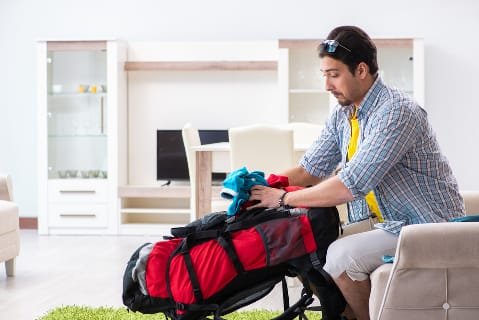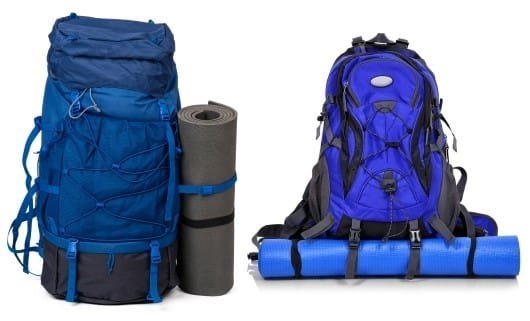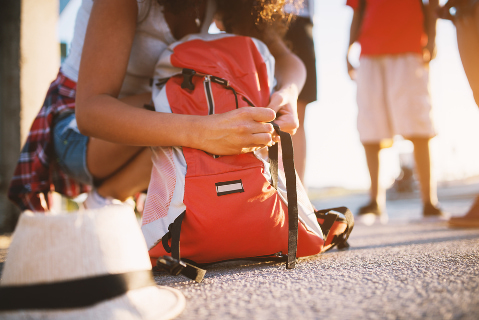Going on a multi-day trip, hike, or even going camping can be fun things to do to get your mind off your general day-to-day life. But packing a backpack for it can certainly be a hassle for many, and some may even reconsider going out anywhere. But what makes them feel this way? When trying not to forget to pack something important, all of a sudden, you may run out of space and start cramming things in there you may not actually need. Later, when you’re on your feet, finally embracing your trip, you start experiencing severe back and shoulder pain because of uneven packing.
Knowing how to distribute weight in a backpack can make an outdoor trip that much easier and enjoyable. The task isn’t and shouldn’t be that difficult for anybody, and by following a few simple guidelines for packing a backpack, you won’t ever see it as a hassle again.
Table of Contents
How Much Backpack Weight Should I Carry?
Every person has their own weight limits when carrying a backpack. The weight you carry on your back will also vary with the type of trip you take and a few other factors. But there are a few guidelines you could follow for a better carrying experience.

For a while now, there have been numerous sources bringing up the “10% and 20% limit” rule for all day hikers and travelers in general. These rules basically state that a day hiker’s backpack should weigh just about 10% of their body weight, and a multi-day backpacking pack should not weigh more than 20% of the carrier’s body weight. This is a very hard rule to follow since not everybody has a weighing machine on hand. These rules are also generally placed for caution more than accuracy. In general though, keeping to as light a load as possible will prevent your backpack’s straps from hurting you and causing back trouble.
People with more petite figures than others don’t necessarily have lighter items to carry, which can leave them carrying well more than 20% of their body weight. It’s mainly about individual limits and how you pack your backpack. Before leaving the house, it’s important to know well in advance what type of trip you’re going on. Is it a day hike or a camping trip or transporting your luggage from city to city? What terrain will you be covering? Will there be a lot of uphill/downhill travel on foot? By answering these questions, you’ll have a clearer idea of how many things to carry in your backpack and what’s essential/non-essential, which will in turn make your journey a lot easier.
A lot of people like to pack light if it’s just a hike or a small excursion. Some food, water, a first aid kit, and that’s about it. But on multi-day camping trips, packing may be more complicated depending on your daily needs. Many like to carry their everyday gadgets, which they deem essential. Blankets, extra clothes, a sleeping bag, and many more items follow, not including food, water, and a first aid kit. If you’re backpacking through a region using public transport and with overnight stops at hostels or hotels, you won’t need all those outdoor things but you will probably need better personal items and clothes.
Ultimately, depending on what trip it is and what your needs are, the weight of your backpack will vary. Along with this, remember to know beforehand what you’re capable of carrying to avoid a tiring adventure.
How to Pack a Backpacking Backpack
Packing for backpacking needs special attention since you’ll have a lot of things to take with you. It may be a long trip, so you’ll have to set some time aside to plan out what to take and especially, where to put it. This will not only help you figure out the final weight of your backpack early but also figure out the backpack’s weight distribution. This order of packing only applies to internal frame backpacks, as external frames are only really useful for certain types of hiking trips.
First, make a backpacking checklist of everything you want to carry with you. This will help a great deal in compartmentalizing before you start packing. Once you have all the items you’re going to pack laid out in front of you, it’s time to start packing. At the bottom of the main compartment of your pack, go ahead and place all the items that you won’t be requiring until you reach the first destination or campsite. These will include softer, less-dense items like your sleeping kit (sleeping bag and pad) or clothes. It’s best not to have any heavy, dense items digging into your lower back, but instead, having cushioned objects at the bottom will provide better lumbar support.
Keep in mind that some larger travel backpacks come with two wheels and a telescopic handle so that if you’re on level ground, you can pull the pack behind you. These packs usually have a flap on the back that folds underneath the pack and covers the wheels when you’re carrying it on your back. When being wheeled, the flap comes back up and keeps the suspension system secure and out of the way.
Next, the middle of your backpack. This is where you place all heavier, dense items. They won’t put much strain on your back or shoulders and won’t throw off your center of gravity. Keeping these in the middle, on top of the sleeping bag or clothes, will also save your backpack from any potential damage if you packed them at the bottom. A camera or hair accessories could go in here if you’re travel backpacking. Make sure to have all these in separate cases to prevent any accidental breakages.

After you’ve evenly spread these items in the middle of your bag, place your folded or rolled up extra clothes in any gaps you find between your heavier items. This will keep the bag more stable, and prevent any internal jostling and shift in weight distribution.
At the top of your bag, pack any remaining items you might have left but would want to be able to access with ease, like your rain jacket. Now that the main compartment is filled, let’s move on to the additional, handy compartments. At the very top, you may find a separate compartment that’s meant solely for items you’d need immediate access to while on foot. Things like a map, torch, or multi-tool, and first aid kit.
One side pocket can be used to hold your water bottle, while the other can be used to hold snacks. A pocket in the front is also usually available to store any larger items you might need urgently, like an extra warming layer. While some backpacks come with a bottom shoe compartment, most won’t, so you’ll need to find a space inside for your extra pair of shoes. It’s also a good idea to keep a shoe bag to slide your shoes into if they get wet. Lastly, in your backpack strap pocket or hip belt pocket, you can keep your phone, keys, and wallet, for easy access wherever you may be.
How to Pack a Hiking Backpack
There are 2 types of backpacks commonly used for outdoor travel on foot. An internal frame backpack and an external frame backpack. But which type would work for a hike? Usually, external frame packs are used for long journeys on well graded paths, to be able to carry heavy loads, very bulky items, or trekking gear, and are heavier overall compared to internal frame ones. This is one of the main reasons why the most commonly used packs are the lighter internal frame designs. They are held closer to the body and are better for hiking on trails where you have to scramble a bit or go off trail. But everyone has their own preferences.
When packing internal frame backpacks for the best weight distribution, the lightest, softest items are widely suggested to be at the bottom for maximum comfort for your lower back as you hike. In the middle, place all the heaviest items such as food-related containers to make the bag sit on your hips better, and at the top, pack all frequently used essentials such as a first aid kit, jacket, snacks, etc. However, there are times when attaching your sleeping bag to the top of your backpack makes more sense.

External frame packs are generally used for longer hikes, coming with a large load-bearing, sturdy frame with space to attach extra gear. This pack is also recommended to keep better posture due to its back support frame. To pack one of these, the order of items is slightly different due to the external frame.
For the best stability, the lightest items should be at the bottom, while the middle would contain mid-weight items if there are any. At the top, carefully pack all heavyweight items such as your water reservoir, flask, and food. Keeping the heavier items at the top will allow your center of gravity to remain stable even if you attach things like tools or a tent to the outside of your pack.
While there is certainly more to packing internal and external frame hiking backpacks, this should give you a good idea of weight distribution for both.
How to Make Your Backpack Lighter
If you’re looking to travel light for more comfort and endurance on foot, then here are a few suggestions on how to reduce backpack weight.
First, make sure you know exactly what type of trip it’s going to be used for. With this in mind, you’ll be able to narrow down essential and non-essential items. The type of bag you use can also determine the overall weight. Internal frame backpacks are much lighter than external frame packs, and depending on how much you’re carrying, the size of your pack and its base weight would also change. However, if you already own a large pack but are looking to travel light, then it’s still possible.
Many ultra-lightweight backpackers carry very few clothes and only one pair of light all-purpose footwear in their pack. Make sure to wear your heavy hiking boots at all times instead of packing them. Pack light and breathable fabric clothes that dry fast naturally after you wash them. Ditch the jeans and go with quick dry cargo pants with pockets that can hold your small accessories. These can help reduce the bulkiness of your pack.
Many times when people go on hikes, their bags are overstuffed with food and water. Though carrying extra food and water is the smart way to go, it’s also very easy to go overboard. Try to pack as much cooked food as possible to reduce the need for cooking equipment. Dry foods like nuts, jerky, and grains can last long in a bag while also giving you the energy you need.
Fruits and raw foods aren’t recommended, as they take up more space and the former can’t be squished into a tight space, while the latter would make cooking equipment a requirement. At the most, carry an all-in-one stove and a single utensil that is small in design but can be used to cook and eat out of.
Foldable bottles and water filters are items that you can use to reduce the weight and have more space in your backpack. While you’re en route, try as much as possible to drink water at certain sources that provide it, rather than carrying too much in your bottle. But at the same time, don’t ever go hiking with an empty bottle.
Try to keep additional, non-essential items like books, games, and cameras, out of your gear list. These will add unnecessary weight. You can really cut back on toiletries by buying or carrying travel size containers.
However, if you are traveling in a group, then it is possible to carry more items and spread them among multiple backpacks. Don’t carry duplicates of anything to keep the weight to a minimum.
FAQs
This depends on what type of backpack you may be carrying. With internal frame backpacks, the heavy items should sit in the middle of the pack for even weight distribution and stability while carrying it on your shoulders. With external frame backpacks, heavy items should sit at the top.
It is generally advised not to carry more than 20% of your body weight in your pack, but this varies with body type. While there is no fixed weight that your backpack pack should be, it’s important to know the weight that suits you the most, to know that you’re carrying what you need, and to know what type of trip you will be on.
According to a study conducted in 2010 by the National Center For Biotechnology Information, carrying a heavy backpack at a young age can cause the spinal cord to compress and cause severe, long-lasting back pain. While the claims that a heavy backpack stunts growth is still being debated, there is proven irreparable damage done to the spinal cord at a young age that will cause back and posture problems when you are older.

